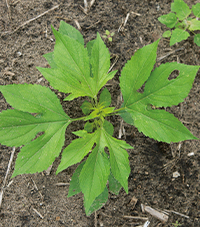 Giant ragweed (Ambrosia trifida) is a summer annual weed found in cornfields across the Midwest. More than an unsightly nuisance, giant ragweed can impact yield and profitability. According to Michigan State University Extension, one giant ragweed plant per 10 square feet can reduce corn yield by 52%.1 Early identification is the first step to control this highly resistant weed.
Giant ragweed (Ambrosia trifida) is a summer annual weed found in cornfields across the Midwest. More than an unsightly nuisance, giant ragweed can impact yield and profitability. According to Michigan State University Extension, one giant ragweed plant per 10 square feet can reduce corn yield by 52%.1 Early identification is the first step to control this highly resistant weed.
Identification
Giant ragweed plants emerge early in the season, typically March through May. They are identified by spoon-shaped cotyledons and sometimes purple stems. The first true leaves have an oval shape that narrows to a point, and subsequent leaves feature a characteristic three-lobed shape (sometimes five-lobed) with a toothed edge. Leaves are often 4 to 8 inches wide and 6 inches long.
Giant ragweed plants thrive in fertile soils and have a vigorous growth rate. Plants can reach up to 16 feet tall in cornfields, producing up to 5,500 seeds in August and September.1 For that reason, management protects yield potential for the current season and helps ensure field productivity for the future.
Management
Giant ragweed plants are notoriously difficult to control due to their growth rate and potential resistance to several herbicides, such as glyphosate. Although tillage controls emerged plants, it can stimulate seed germination and produce additional flushes. The best approach to giant ragweed management combines an herbicide program with cultural and agronomic practices.
A solid program approach begins with preplant or preemergence application of a broad-spectrum herbicide, such as Resicore® herbicide. Resicore includes three modes of action to control more than 75 of the toughest weeds, including giant ragweed. For postemergence applications, opt for a second application of Resicore or choose a product such as Realm® Q herbicide, which combines multiple modes of action with a crop safener.
Looking to next season, consider several additional management options, especially if weed populations are high this season. Crop rotation is an excellent way to control weeds. Small grains help suppress giant ragweed, and forage crops allow control through mowing. You could also consider a later planting date to incorporate tillage after giant ragweed emergence. This practice works best for giant ragweed populations that don’t have extended emergence throughout the early season.1
Giant Ragweed Resources
Use these tips to put giant ragweed in its place this season and prepare for clean fields next year. Check out the links below for more information on giant ragweed, and visit the Corn Herbicides Portfolio page on Corteva.us to learn about Resicore, Realm Q and other corn herbicide solutions.
- Biology and Management of Giant Ragweed — University of Missouri
- Weed ID Guide — University of Missouri
1Giant Ragweed: https://www.canr.msu.edu/weeds/extension/giant-ragweed
™ ® Realm® Q and Resicore® are not registered for sale or use in all states. Resicore is not available for sale, distribution or use in Nassau and Suffolk counties in the state of New York. Contact your state pesticide regulatory agency to determine if a product is registered for sale or use in your state. Always read and follow label directions.
The More You Grow
Find expert insights on agronomics, crop protection, farm operations and more.